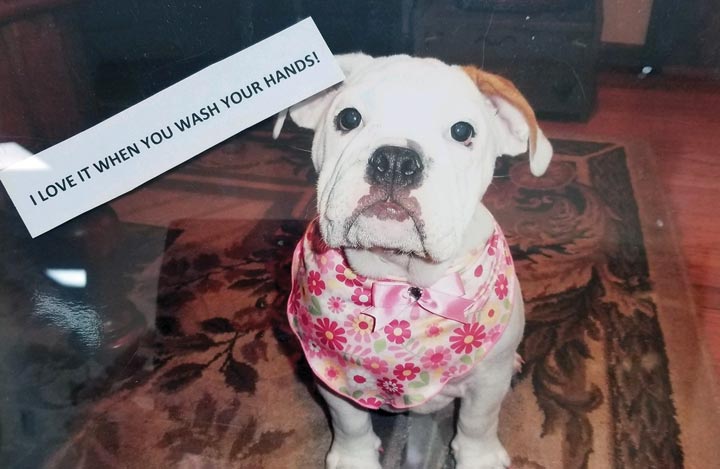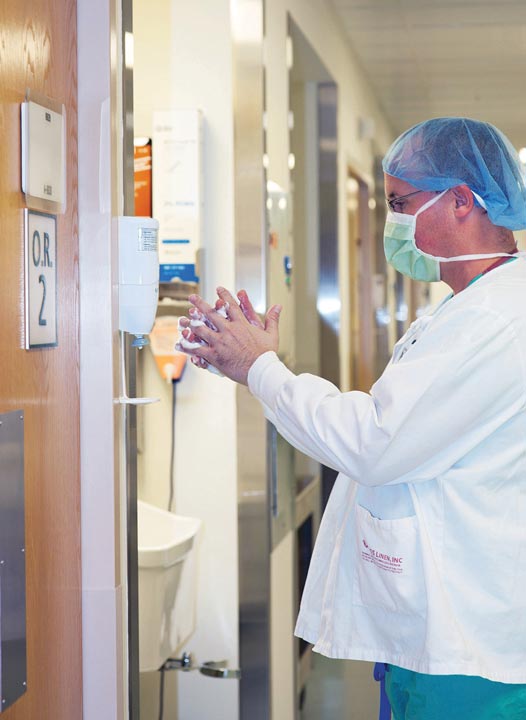- Home
- Article
A Small Act With a Big Impact
By: Cynthia Wiersema, RN
Published: 8/1/2025
Sustained hand hygiene practices reduce risks of surgical-site infections. Here’s how to reinvigorate compliance.
It seems so simple: Clean hands provide a safe environment for patients. But as anyone who works at a surgical facility knows, sometimes the most basic things — especially those that must be performed dozens of times a day — can be the most difficult to maintain consistently.
Simply put, hand hygiene matters. Decades of research has shown proper hand hygiene’s efficacy in reducing healthcare-associated infections that can be transferred by touch, including pathogens like methicillin-resistant Staphylococcus aureus (MRSA), Clostridium difficile and even common cold viruses. In a surgical environment, where patients are especially vulnerable, even one lapse can lead to significant complications such as surgical site infections (SSIs).
Amid the fast pace of a surgical setting, constant interruptions and even hand irritation from frequent washing make it easier for even veteran, well-trained staff to forget to clean their hands. Consider how many vendors and patients’ loved ones visit your facility each day, and it’s even more likely that someone will slip up on hand hygiene without even realizing it. The problem with that is just one lapse can be all it takes to cause an infection.
That’s why one of the toughest but most vital aspects of improving hand hygiene practices is to get it to become a lasting habit that sticks. It’s not that staff don’t know what to do or don’t want to do it, but inevitable day-to-day distractions can constantly get in the way of optimal compliance.
Effective strategies
To overcome these challenges, I’ve found it helps to build a culture where everyone feels responsible about hand hygiene and sees it as a crucial part of keeping patients safe, rather than just another task to check off the list. In my experience, effective strategies to boost compliance include:
• Visual reminders such as posters, placards and stickers at handwashing stations, in patient care areas and in common areas such as hallways ensure that staff, patients and visitors see constant prompts about the importance of hand hygiene and how to properly wash their hands.
• Prioritize regular hand hygiene education for staff, because even the best-trained employees need refreshers to keep it top of mind. This can be as simple as raising the topic in safety huddles or other regular team meetings, or more formal training if you think your facility would benefit from it.
• Hand hygiene products should be both easily accessible and gentle on the skin. People are less likely to use these products if they need to search for them or if their use causes irritation.
• Leaders must walk the talk by setting a good example. Conversely, when leaders don’t visibly engage in hand hygiene best practices, neither will some members of the staff.
• Make these good habits part of the routine daily workflow of staff. Hand hygiene should feel like a natural, intuitive act rather than a forced dictum. A strong, positive team attitude regarding hand hygiene is the foundation for success.

If you want your hand hygiene reminders to stick, it helps to make them memorable. When Lisa York, RN, BSN, MSN, CASC, executive director of Hunterdon Center for Surgery in Flemington, N.J., noticed hand hygiene compliance starting to slip, she took drastic and adorable action by adding pictures of her English bulldog Lilly to the reminders. “I took down our standard ‘please wash your hands’ signs from around our facility and replaced them with pictures of Lilly with clever captions in an effort to capture our staff's attention and get them to focus on handwashing,” she says.
(Editor’s Note: The story of Ms. York’s bulldog-buoyed hand hygiene reminders was originally featured as an Idea That Works in the June 2019 issue of Outpatient Surgery Magazine, but the fun and timeless tactic seemed to fit here so we brought it back for an encore.)
A collaborative effort
A successful hand hygiene program requires buy-in from everyone on site: staff, patient families and other visitors. Those who visit your facility only occasionally can be the most difficult to teach.
In our center, we’ve found that leading by example and talking about hand hygiene out loud makes a big impact. Our staff makes a point to say things like “give me a quick moment to wash and sanitize my hands” so patients and families get the message that we prioritize hand hygiene. It’s a subtle but powerful way to show them that we value their safety.
When hand hygiene is a natural part of the conversation, it encourages everyone, including visitors, to follow suit. By creating a sense of shared responsibility, the process feels more like a team effort rather than something you’re being nagged to do.
Make sure hand sanitizer is easy to access and convenient throughout the building for everyone, so it’s always available.
In a busy outpatient setting, these small but intentional moves help build a culture where safety is always visible and always a shared endeavor.
Follow up for consistency
Having great policies and training in place isn’t enough, however. It’s extremely important to be consistent and to follow up with people. Hand hygiene initiatives can’t be a one-and-done type of effort if you want them to become universal and sustainable. It takes ongoing communication, modeling from leadership and reinforcement about why the practices are in place to get the message across.
There are several options for monitoring the success of your hand hygiene program, including audits and peer reviews. Whichever monitoring methods you choose, however, it’s important to not just point out the slip-ups, but celebrate the wins as well.
It’s always difficult to change old habits or create new ones, so when compliance improves or someone goes out of their way to do the right thing, a little recognition goes a long way and can help keep the momentum going. Something as simple as a shout-out to a team that has improved its practices can make those employees feel their efforts have been recognized and appreciated as important to the center.
Given the breakneck pace of same-day surgery, it’s those everyday habits and small moments that add up to a strong safety culture.
Product type and placement

You can have all the hand sanitizer in the world, but if people can’t find it — or feel it’s difficult to use — hand hygiene compliance will decline.
There are a lot of great hand hygiene products out there, but in our ASC, we’ve had great results using a quick-drying antiseptic foam that has added moisturizers so it doesn’t dry out your hands. That’s an important consideration, especially for our clinical team, who constantly move among all three perioperative phases of care and need to sanitize multiple times per hour.
Remember to make sure hand hygiene dispensers are placed exactly where they’re needed — in room entries, near patient bays, in the lobby. Not only does that make it easier for people to comply with the policy, but your hand hygiene dispensers and stations also serve as ubiquitous visual reminders that send the message that whenever someone enters a new area, they need to sanitize. Do whatever is necessary to have hand hygiene become part of the natural workflow at your center.
Hand hygiene is a lot more than just another box to check off on a list of tasks. It’s a reflection of our commitment to everyone’s safety and providing quality care. Cleaning your hands is a small act with a big impact. By making hand hygiene a visible, shared priority — supported by accessible products, visual reminders, ongoing discussion and leadership that sets the right example — we create a culture where safety is second nature for all. OSM
.svg?sfvrsn=be606e78_3)
.svg?sfvrsn=56b2f850_5)